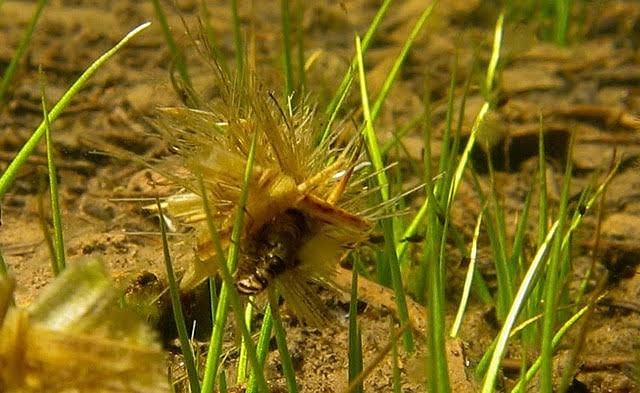Newcomers May Change Ecosystem Functions – Or Not

For Immediate Release
In a study tracking climate-induced changes in the distribution of animals and their effects on ecosystem functions, North Carolina State University researchers show that resident species can continue managing some important ecological processes despite the arrival of newcomers that are similar to them, but resident species’ role in ecosystem functioning changes when the newcomers are more different.
The findings could lead to predictive tools for understanding what might happen as climate change forces new species into communities, such as the movement of species from lower to higher latitudes or elevations.
“Species are expanding their ranges due to climate change, but what are the consequences to the existing structure and function of the ecosystem?” said Brad Taylor, professor of applied ecology at NC State and co-author of a paper describing the study. “Our study suggests that when resident and newcomer species are fairly similar, the consequences for ecosystem functions may not matter.”
The study examined a 30-year record of caddisfly populations in normally pristine ponds in Colorado, as well as some fundamental ecosystem functions that can be linked to an ecosystem’s health: the amounts of nitrogen and phosphorus excreted by the caddisflies and how fast dead plant material, or detritus, that enters ponds is processed by caddisflies. Resident and newcomer species can affect these processes in similar or different ways depending on who is in the community.
Shifts in nitrogen and phosphorus levels could lead to changes in the algal community, which is the food source that supports organisms higher up the food chain, such as fish or amphibians, Taylor said.
Meanwhile, caddisflies have an important role in detritus processing, as they consume decomposing wetland plant material and break it down into smaller pieces that can be consumed by other organisms. Taylor described an ecosystem with high detritus processing as one that is generally performing well.
The study reported three range expansions in caddisfly populations in the 30-year period; in the first two, caddisfly species similar in their processing of detritus and nutrients to resident caddisflies moved into the ponds. One similar newcomer species took a larger role in supplying nitrogen during the 30-year period.
Later, during the third expansion, one newcomer that was dissimilar to most resident species took over supplying phosphorus, but the overall processing of detritus and supply of nutrients in the ecosystem did not change despite these alterations in the community, Taylor said, and no evidence was found of declining caddisfly populations over time, although the dissimilar newcomer is on the verge of becoming the dominant resident.
“We have a unique temporal data set that documents the potential consequences of climate-induced introductions of species into new communities and ecosystems,” Taylor said. “A key part of predicting the potential effects of shifts in species is knowing the species-specific rates of nitrogen and phosphorus supply and the processing detritus.
“Nitrogen and phosphorus limit algae in these ponds, but how will changes in dominant species like caddisflies alter the abundance of these nutrients?” Taylor added. “What will be the change in the algal community when you get more phosphorus supply from a newcomer like the caddisfly we call nemo – short for the genus Nemotaulias – for example?”
Taylor and his collaborators intend to follow up on the long-term consequences of these expansions by examining their effects on other invertebrates and vertebrates given these changes.
“We know these range expansions are occurring and are going to continue occurring,” Taylor said. “We were able to measure three ecosystem processes in this study – there is still a lot more to explore.”
The study appears in Communications Biology. Corresponding author Jared Balik, a former Ph.D. student and postdoctoral researcher at NC State, Hamish Greig of the University of Maine-Orono and Scott Wissinger of Alleghany College are paper co-authors. The study was funded by the National Science Foundation under grants 1556914 and 1641041.
-kulikowski-
Note to editors: The paper abstract follows.
“Consequences of climate-induced range expansions on multiple ecosystem functions”
Authors: Jared A. Balik and Brad W. Taylor, NC State University; Hamish S. Greig, University of Maine, Orono; and Scott A. Wissinger, Alleghany College
Published: April 10, 2023 in Communications Biology
DOI: 10.1038/s42003-023-04673-w
Abstract: Climate-driven species range shifts and expansions are changing community composition, yet the functional consequences in natural systems are mostly unknown. By combining a 30-year survey of subalpine pond larval caddisfly assemblages with species-specific functional traits (nitrogen and phosphorus excretion, and detritus processing rates), we tested how three upslope range expansions affected species’ relative contributions to caddisfly-driven nutrient supply and detritus processing. A subdominant resident species (Ag. deflata) consistently made large relative contributions to caddisfly-driven nitrogen supply throughout all range expansions, thus “regulating” the caddisfly-driven nitrogen supply. Whereas, phosphorus supply and detritus processing were regulated by the dominant resident species (L. externus) until the third range expansion (by N. hostilis). Since the third range expansion, N. hostilis’s relative contribution to caddisfly-driven phosphorus supply increased, displacing L. externus’s role in regulating caddisfly-driven phosphorus supply. Meanwhile, detritus processing contributions became similar among the dominant resident, subdominant residents, and range expanding species. Total ecosystem process rates did not change throughout any of the range expansions. Thus, shifts in species’ relative functional roles may occur before shifts in total ecosystem process rates, and changes in species’ functional roles may stabilize processes in ecosystems undergoing change.


